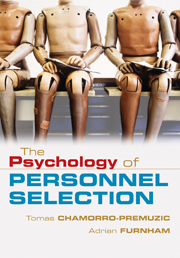Book contents
- Frontmatter
- Contents
- List of boxes
- List of figures
- List of tables
- Prologue and acknowledgements
- Part 1 Methods of personnel selection
- 1 Early, unscientific methods
- 2 The interview
- 3 Letters of recommendation
- 4 Biodata
- 5 Situational judgement tests and GPA
- Part 2 Constructs for personnel selection
- References
- Index
1 - Early, unscientific methods
from Part 1 - Methods of personnel selection
Published online by Cambridge University Press: 05 June 2012
- Frontmatter
- Contents
- List of boxes
- List of figures
- List of tables
- Prologue and acknowledgements
- Part 1 Methods of personnel selection
- 1 Early, unscientific methods
- 2 The interview
- 3 Letters of recommendation
- 4 Biodata
- 5 Situational judgement tests and GPA
- Part 2 Constructs for personnel selection
- References
- Index
Summary
Introduction
Since the beginning of time, individuals have had to make ‘people decisions’: who to marry, to employ, to fight. In recent decades, sociobiology and evolutionary psychology have suggested that many of these apparently (quasi-logical) decisions are based on powerful people markers that we respond to, but are unaware that we are doing so. We assess people on a daily basis. There is, however, in every culture, a rich and interesting history of the techniques groups have favoured in making people decisions. Many of these techniques have quietly passed into history but others remain in use despite being rigorously tested and found wanting.
It appears that there have always been schools of thought with their ingenious methods that assess and reveal the ‘true nature’ of individuals, specifically their qualities, abilities, traits and motives. It is patently obvious that people are complex, capricious and quixotic. They are difficult to actually read, to understand and therefore to predict. Neither their virtues or values nor their potential for disaster are easily apparent. People are deceptive, both in the impression management and self-delusional sense. Some are self-aware: they know their strengths, limitations, even what really motivates them; they may even be able to report their condition. Many others are not.
Charlatans, snake-oil salesmen and their ilk find easy pickings among those who feel they need to evaluate or assess others for work purposes. The odd thing is that many of these disproved, pre-scientific, worthless and misleading systems still exist.
- Type
- Chapter
- Information
- The Psychology of Personnel Selection , pp. 3 - 29Publisher: Cambridge University PressPrint publication year: 2010

